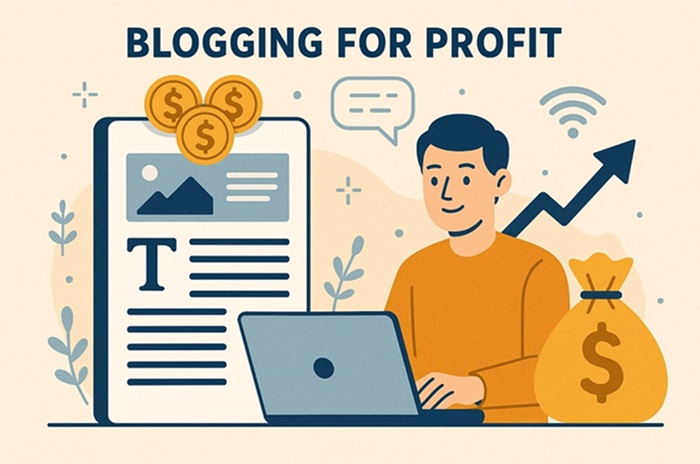How to Run Your Blog Like a Business (Even if you’re just starting out)
You should run your blog like a business, even if it’s just your hobby.
To make money with your blog, you must run it like a business. To attract readers to your blog, you must run it like a business. To have a successful hobby blog, you should still run it like a business.
Many beginner bloggers overlook the business side of blogging, and as a result, they miss out on numerous growth and profit opportunities.
Whether you’re just starting out or you’ve been blogging for a while, you can start to run your blog like a business now, and I’ll show how to do just that with this guide.
Adopt a Business Mindset Early
Try to adopt a business mindset early and run your blog like a business from the start, if possible.
A business mindset separates hobby bloggers from pro bloggers. If you keep thinking like a hobby blogger, it’s easier to miss opportunities. If you think like a pro blogger, then you’ll be looking everywhere for opportunities to grow and profit from your blog.
You should be treating every effort you make, your time, and any activity you do on your blog as if it were an investment.
It’s important to set clear and realistic expectations as a business blogger. You want traffic, revenue, authority, and community, right? None of this happens overnight, so smaller, realistic goals are going to be what will keep you going.
Create a Simple Business Plan for Your Blog
To run your blog like a business, you need to create a simple but effective business plan for your blog.
Try to outline what your business plan will look like. It should have a clear mission, a defined target audience, and well-defined goals. This plan will serve as your playbook for moving forward with your blog.
Start with a basic plan. You don’t have to write a book in order to plan how you will run your blog like a business. You can keep it all on one page, and it can still be a great plan.
A great example formula for a Blog Business Plan might look like this:
- Blog Mission / Values / Goals
- Your Target Audience / Their Pain Points
- Blog Content Strategy
- Blog Marketing Strategy
- Monetization Strategy
Add those simple sections above and fill in the blank. You don’t need to write a lot of information, either. Simply add a sentence or two to get your basic plan underway.
Know Your Audience Like a Business Knows Its Customers
In order to run your blog like a business, you need to know your audience like a business would know its customers.
Before starting a blog, define your target audience. You will never know who to blog to or what to blog about without understanding who your audience is. Create a customer persona or avatar of your target audience to fully understand who you’re creating for.
You need to know your audience’s pain points. These are their biggest wants, needs, questions, and challenges. Once you understand your audience’s pain points, you can create more effective content, products, and services that will resonate with them.
The internet is filled with tools to help you learn and understand your audience. You can look for and reach them on social media, forums and chat rooms, question-and-answer sites, and through keyword research. Look for what they ask or complain about the most to better understand their pain points.
Set Up the Right Systems and Tools
Setting up the right systems and using tools can help you run your blog like a business.
A good start is email. Get a professional email account that features your domain name. I use Google Workspace and connect my domain name, allowing me to leverage the power of Gmail while still using my website domain name.
Utilize analytics on your blog to track user activity. I suggest using Google Analytics, Google Search Console, and MonsterInsights for WordPress to make it easier to understand the metrics. Ensure that you include any tracking activities in your privacy policy as well.
Create an editorial calendar for your blog and keep it up to date. This is your planned posts, due dates, target keywords for SEO, and any additional ideas you might have. I use a simple spreadsheet, either Google or Microsoft.
Consider tools for your WordPress blog if that’s what you’re using. Have a site and database backup system in place, install security tools, and optimize performance to protect your blog’s assets. Blogs can get hacked, break down, or slow down, and you have to stay on top of those issues, or it can become a problem.
Focus on Branding and Presentation
Branding is a crucial part of the success of running your blog like a business, which many beginners overlook and miss numerous great opportunities in the process.
You should at least have basic business-level branding. This means that your blog should have its own domain name, logo, and a consistent theme everywhere, including social media and elsewhere. Try to maintain a consistent look everywhere so that people will start to notice and recognize you.
Your blog design should be simple yet brandable, conveying trust and professionalism within your niche or industry.
People do and will judge a book by its cover. First impressions are really important in the blogging world. They matter for credibility and authority, and you need to take them seriously to run your blog like a business.
Treat Content Like a Product
Start treating your content like a product if you want to run your blog like a business.
Consider each post you make as a part of your inventory. Each post is a product that your readers (customers) will consume. No one wants to consume a product unless it answers their questions and solves their pain points.
Your content needs to be of the highest quality. You need to consistently create content on a regular basis. Your content needs to be valuable and solve the problems of your readers.
Evergreen content is going to be your best bet. This is because it stays fresh, and it doesn’t have an expiration date. However, trending content that will eventually expire is still a good idea as long as it’s valuable to your target audience.
Build Revenue Streams from the Start
Try to focus on building revenue streams from the start of launching your blog.
There are many different types of revenue streams to choose from. You can use ad networks (such as Google AdSense) and affiliate marketing, but a middle person will earn a commission with you. I suggest using your own products and services to maximize your profit margins.
Just make sure you use more than one income stream. Focusing on just one is great until it dries up and you’re no longer earning from it. Multiple streams of income will mean that you will be earning revenue from more than one thing on your blog.
Choose a few streams of income to start with. Ads and affiliate marketing a very easy couple of streams while you work on bigger profit producers. Later, consider launching a paid membership site or a course to maximize your revenue earnings.
Track Performance and Adjust
In order to run your blog like a business, you’ll need to track what is working and adjust what is not working.
Try to track your key metrics in blogging. That’s going to be traffic to your content, your engagement rates, conversions within your funnel, and revenue earnings. Keep a spreadsheet with this data and record it on a weekly basis.
Check your data each month to see what is working well and what is not. Then, check your data quarterly and annually. It’s good to give things a year and then adjust as needed.
For example, if Instagram is bringing you traffic within a year, but Facebook isn’t, then you might want to ditch Facebook or change the way you market on it. Try not to focus on something that just isn’t working for your blog. Focus on what works and double down on that approach while continuing to experiment with other strategies.
Network and Market Like a Business
You should network and collaborate with others in your niche and industry whenever possible.
Find other blogs, creators, and businesses in your niche or industry. Do collaborations with them, such as social media partnerships and guest blogging. Not only will you get more backlinks and readers, but you’ll also network and develop healthy relationships with other experts in your industry.
Build healthy and friendly relationships with other bloggers, creators, and brands within your niche. You’ll most likely need to reach out to them. A good way to do that is by becoming an active contributor on their social media accounts or regular comments on their blog posts.
Networking is not an afterthought. It’s a business growth strategy. There are numerous opportunities when you involve other experts in your industry, and if you ignore them, you’ll miss out on many great things.
Think Long-Term Sustainability
To run your blog like a business, you need to think about long-term success and sustainability.
As you earn profit with your blog, consider reinvesting that profit into tools to help you grow your earnings. Perhaps you can invest in education and learning opportunities to enhance your expertise and establish yourself as an authority in your niche. You may even consider outsourcing to make things easier.
When you treat your blog like a business, it usually means you go all in. This can overwhelm you and burn you out if you don’t take precautions. Learn how to delegate to others and create systems that will help you manage your time and priorities better.
Be sure to adjust your strategy to scale up your blog business. Over time, you’ll want to consider adding a newsletter, courses, a membership community, and other products and services to grow your audience and increase profits. You just need to plan and prepare for these things so that you can ease into them without worry.
Final Thoughts on How to Run Your Blog Like a Business
You can see how easy it is to run your blog like a business.
You don’t have to wait until your blog has been around for years or is super big. You can start at the beginning or even in the middle. The important thing is to treat it like a business as soon as possible, because it gets better after that.
If you enjoyed reading this article and would like to see more like it, consider making a small one-time donation.
Subscribe to my free newsletter for more exclusive blogging tips and resources. Join my free discussion forum all about running your own blog and online community.
About the Author
Shawn Gossman has created content, blogged, ran online communities, and shared a passion for digital marketing for over twenty years. Shawn believes the best way to help content creators, businesses, brands, and marketers is to give away more than you sell. The same advice is recommended for the readers who follow this blog. Shawn also offers various services for extra help in content creation and blogging.
Grow your online brand with exclusive tips from me sent right to your inbox!



